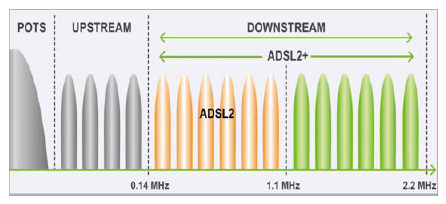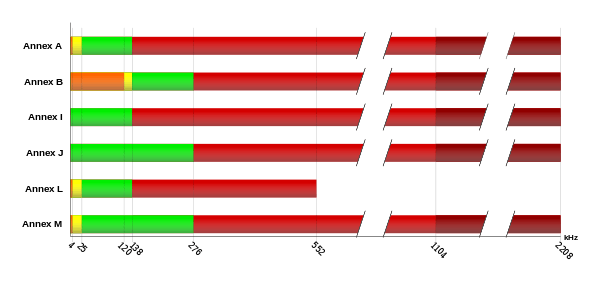G.992.3
ITU G.992.3 is an ITU (International Telecommunication Union) standard, also referred to as ADSL2 or G.dmt.bis. It optionally extends the capability of basic ADSL in data rates to 12 Mbit/s downstream and, depending on Annex version, up to 3.5 Mbit/s upstream (with a mandatory capability of ADSL2 transceivers of 8 Mbit/s downstream and 800 kbit/s upstream). ADSL2 uses the same bandwidth as ADSL but achieves higher throughput via improved modulation techniques. Actual speeds may decrease depending on line quality; usually the most significant factor in line quality is the distance from the DSLAM to the customer's equipment.

Annex versions
ADSL2 has multiple modes for DSL providers to offer services for different needs. Below is a list of available features based on ADSL2 specs from the ITU standards.

| Annex version | Spec | Description |
|---|---|---|
| A | xDSL over POTS | xDSL service functioning over plain old telephone service. |
| B | xDSL over ISDN | xDSL Services running over Integrated Services Digital Network. |
| C | xDSL in ISDN | xDSL System operating in the same cable as ISDN as defined in ITU-T Rec. G.961 Appendix III (Currently not implemented) |
| D | ATU-C and ATU-R state diagrams | See Annex D/G.992.3 |
| E | POTS and ISDN-BA splitters | See Annex E/G.992.3. For operation according to Annexes A,B and I, the G.992.3 requirements applying over a frequency band up to 1104 kHz shall be met over a frequency band up to 2208 kHz. |
| F | ATU-x performance requirements for region A (North America) | F.1 Performance requirements for operation of ADSL over POTS (Annex A) F.2 Performance requirements for operation of All Digital Mode ADSL (Annex I) F.3 Performance requirements for operation of ADSL over POTS with extended upstream bandwidth (Annex L) |
| G | ATU-x performance requirements for region B (Europe) | G.1 Performance requirements for operation of ADSL over POTS (Annex A) G.2 Performance requirements for operation of ADSL over ISDN (Annex B) G.3 Performance requirements for operation of All Digital Mode ADSL (Annex I) G.4 Performance requirements for operation of All Digital Mode ADSL (Annex J) G.5 Performance requirements for operation of ADSL over POTS, with extended upstream bandwidth (Annex L) |
| I | All Digital mode ADSL with improved spectral compatibility with ADSL over POTS | Extending ADSL band to use the voice frequency range, 32 upstream tones for an additional 256 kbit/s upstream data rate over POTS lines. |
| J | All Digital mode ADSL with improved spectral compatibility with ADSL over ISDN | Extending ADSL band to use the voice frequency range, 64 upstream tones for an additional 256 kbit/s upstream data rate over ISDN Lines. |
| L | Reach Extended | Increases the range of the DSL service enabling the link to work at a distance of 7 kilometres (23,000 ft) |
| M | Increased Upload speeds | Upstream/downstream frequency split has been shifted from 138 kHz up to 276 kHz, allowing maximum upstream bandwidth to be increased from 1.4 Mbit/s to 3.3 Mbit/s. |
See also
- ADSL
- ADSL2+
- List of device bandwidths
- Sealing current
External links
- ITU-T Recommendation G.992.3: Asymmetric digital subscriber line transceivers 2 (ADSL2)